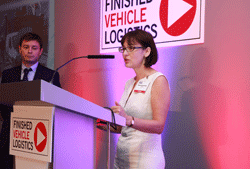 Carmakers and logistics providers operating in Russia are looking at the development of ports in the south of the country around the Black Sea, with small ro-ro facilities and shipping services beginning at the port of Novorossiysk.
Carmakers and logistics providers operating in Russia are looking at the development of ports in the south of the country around the Black Sea, with small ro-ro facilities and shipping services beginning at the port of Novorossiysk.
For several years manufactures have used Ukrainian ports, including Illychevsk and Sevastapol, with capacity limited in Russian Black Sea ports. Both Volkswagen Group and Toyota have expressed interested in developing a Black Sea entry point to Russia, although neither have yet to commit to a new route there.
Gefco is working with short-sea provider Neptune Lines and TBMS Logistics, a Russian provider of ocean carriage and multimodal forwarding of project cargoes, on moving vehicles via Novorossiysk Commercial Sea Port.
Speaking at last week’s Automotive Logistics Russia conference in Moscow, Gefco’s finished vehicle logistics manager in Russia, Maria Polianskaya, said that the company started developing a Black Sea entry point in Novorossiysk in 2010 as a means of levelling out the impact of market volatility that was making it practically impossible to plan for the future.
“We saw that the southern region accounts for about 12% of Russia’s vehicle market,” said Polianskaya. “Carriers go there regularly but they come back empty. Ideally they should be loaded both ways.”
Gefco looked south with ideas of optimising the number of carriers, reducing the cost of delivery and shortening the delivery time, and it looked at production facilities in Turkey, Spain, Portugal and Italy as sources of return hauls. The problem the project faced was that there were no ports handling vehicle volumes in the south region.
“After the collapse of the Soviet Union the south of Russia had little development in terms of sea ports,” said Alexander Bulygin, a partner at TMBC Logistics. “The situation is the same now. The only sea port that can be used is Tuapse but the issue there, as at Novorossiysk, is that there is no storage space.”
The 2009 recession and drop off in cargo allowed Gefco and TMBC to free up some space at Novorossiysk. This has resulted in Gefco securing two terminals with a combined space of just more than 40,000 square metres. This is small in comparison with the bigger terminals in Russia, but Gefco has engineered the compound and pushed load optimisation over a seven-day week so that it now clears three vessels a month with the capacity for 50 trucks to call per day. The facility offers remote customs clearance and its success led to the opening of another facility in June this year for additional capacity, according to Polianskaya.
Bulygin added that the port had improved performance and had the potential to process anything up to 100,000 cars a year.
Carmakers looking for options
Toyota is one of the carmakers looking for a port in the Black Sea and waiting for the development of customs posts. Olga Valieva, director of Finished Vehicle Logistics at Toyota Motor Russia, said that if such a solution were to be found, vehicles produced at its plant in Turkey would be transferred via that route.
“We want to develop the southern route with proper port on the Black Sea,” she said. “‘Proper’ means in terms of its capacity for essential volumes, depth of berth and general infrastructure, which is essential for an automobile terminal. We also anticipate the development of customs infrastructure in the south.”
Volkswagen Group Rus’s Zdenek Dresler, head of group service division, also expressed interest in using the Black Sea for entry into Russia.
Entry via Ukraine
Ukranian ports continue to attract shipping services, with some OEMs using them for onward delivery to Russia. For example, Wallenius Wilhelmsen Logistics (WWL) now calls at Sevastapol on the southern tip of Ukraine for Chinese OEM FAW. There are no space problems at Sevastapol, according to Søren Tousgard Jensen, managing director, Russia. WWL makes a monthly delivery of 500 vehicles, using feeder vessels from the ports of Piraeus, Greece and Derince, Turkey.
Jensen said an accurate forecast on potential volumes to Black Sea ports is difficult but there is considerable demand for establishing entry ports there. However, the capacity at Russian ports is still strained.
“We have a lot of requests from all the carmakers, and high and heavy manufacturers, for entry ports in the Black Sea,” said Jensen. “The limiting factor is what the port can handle. If we open the floodgates and say we can offer a service into Novorossiysk or any other place then we will have everybody immediately coming up. It is a capacity issue.”
Back in February this year short sea transport provider Mediterranean Car Carriers Line (MCCL) established a ro-ro service for finished vehicles between the port of Koper in Slovenia and ports in the Black Sea.
A dedicated PCTC vessel with a capacity of 750 cars, which is also able to load trucks, buses and project cargo, included high & heavy units, is making calls at the port of Koper every 20 days moving onto Piraeus, Derince and Poti in Georgia.
Read the full report from Automotive Logistics Russia 2013 here.


































